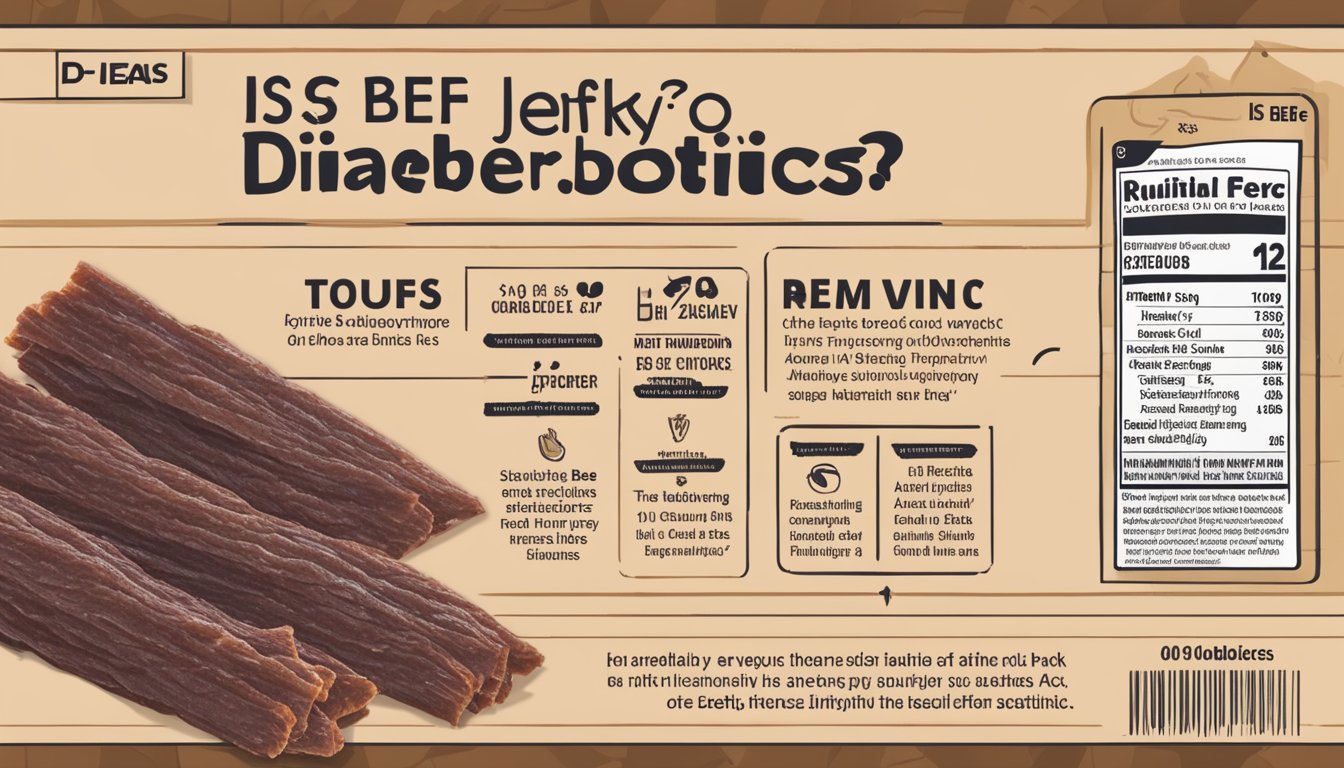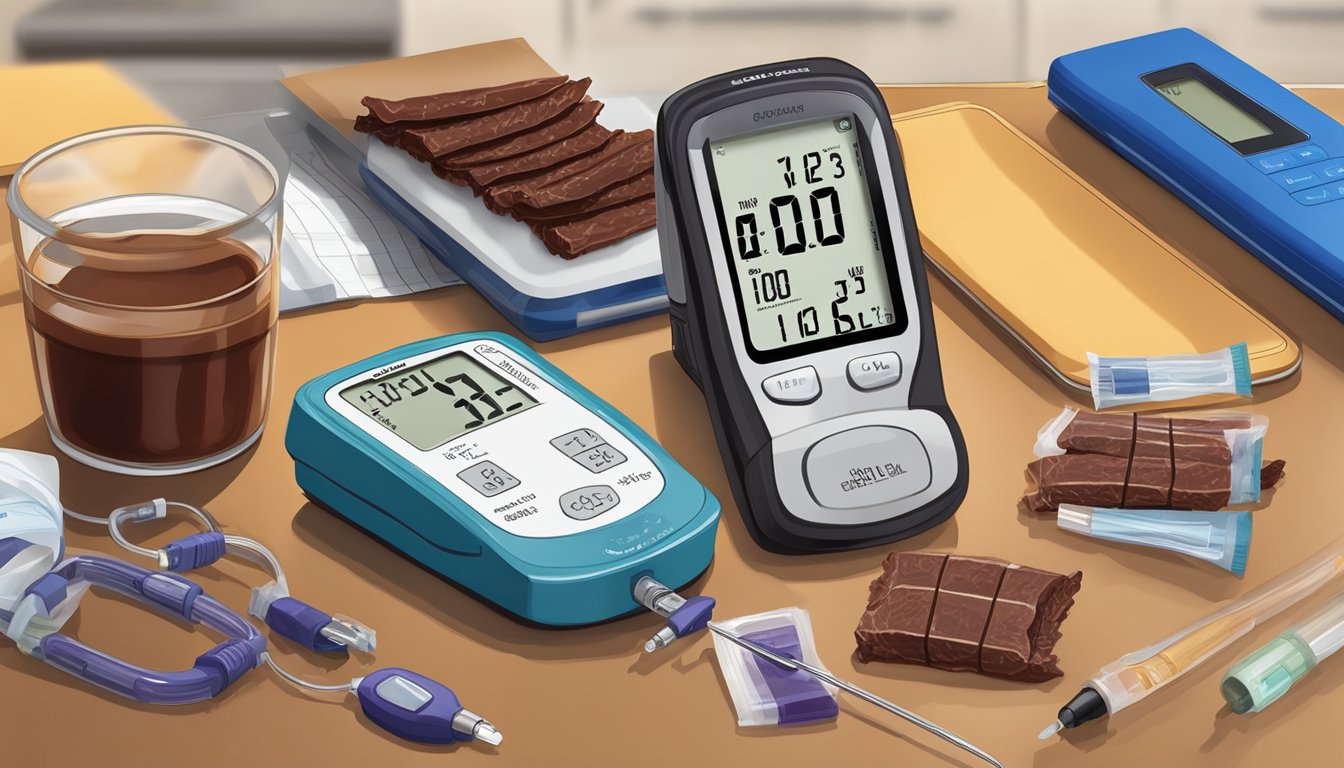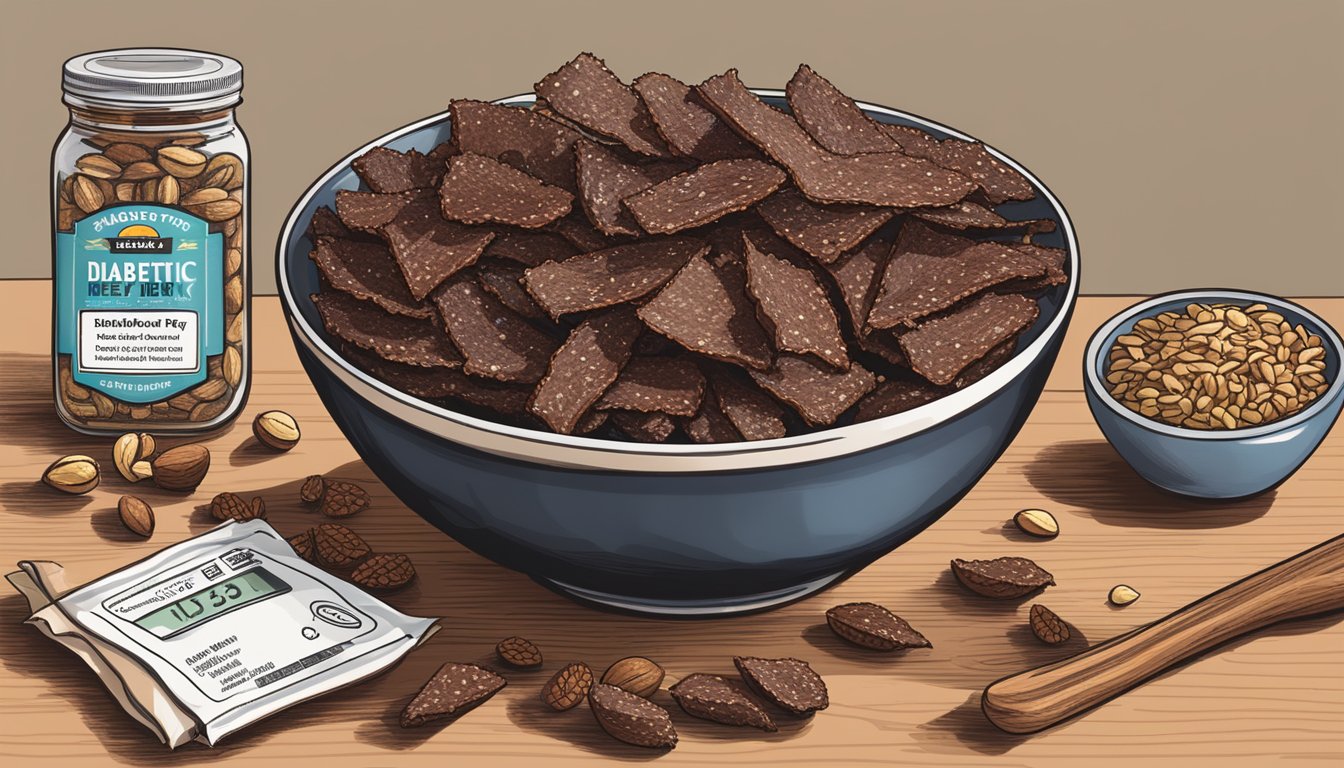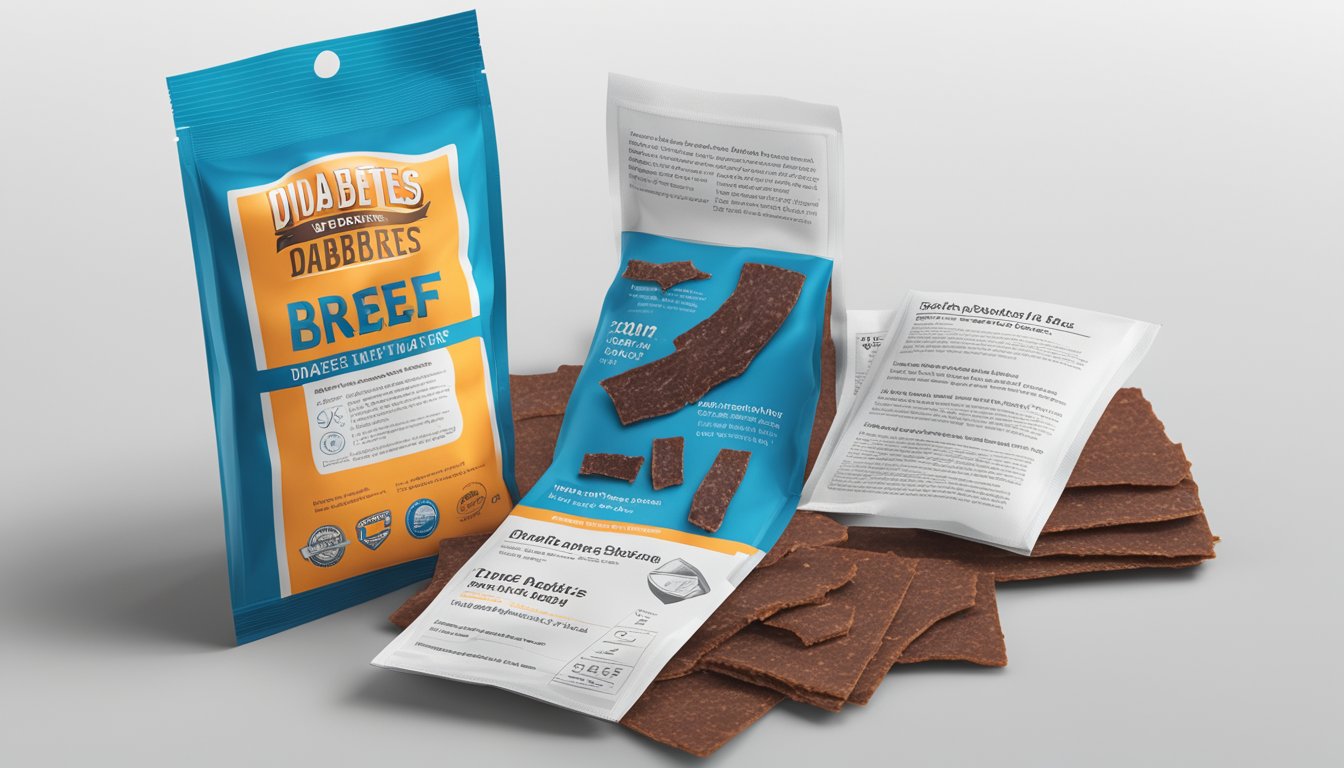Beef jerky can be suitable for diabetics when low in sugars and carbohydrates. Reading labels and selecting high-quality, minimally processed jerky is crucial. Jerky from grass-fed beef often provides better nutritional value for diabetics.
When considering snacks suitable for managing diabetes, the question of whether beef jerky is a good option for diabetics arises. It’s important to recognize that diabetes requires careful monitoring of carbohydrate and sugar intake to maintain blood sugar levels. Beef jerky, when chosen correctly, can be a high-protein, low-carb snack that fits into a diabetic’s meal plan. However, standard jerky products may contain added sugars and high levels of sodium, which are less ideal for diabetics.

Attention should be paid to the nutritional profile of beef jerky, including its sodium, fat, and carbohydrate content. Some beef jerky is specifically crafted to be low in sugar and carbohydrates, which can be beneficial for diabetics seeking healthy snack options. It is also essential to consider the meat’s quality; for instance, jerky made from grass-fed beef tends to have a more favorable nutritional composition. Diabetics need to select jerky that aligns with their dietary needs for optimal health benefits and blood sugar management.
Understanding Diabetes and Dietary Needs

Diabetes requires careful management of blood sugar levels to reduce the risk of complications. This includes a focus on maintaining a balanced diet that supports blood sugar control and addresses insulin resistance.
Essentials of a Diabetic Diet
A well-structured diabetic diet is fundamental for managing diabetes. Such a diet emphasizes nutrient-dense foods that provide vitamins, minerals, and fiber. These elements are essential for balancing blood glucose and reducing insulin resistance. A diabetic diet should include a variety of foods such as:
- Whole grains for sustained energy release
- Lean proteins for muscle maintenance and repair
- Healthy fats for cardiovascular health
- Abundant fiber from fruits, vegetables, and legumes for digestive health
This approach to eating not only addresses the requirements of managing blood sugar levels but also supports overall health, ensuring that each meal contributes positively to the individual’s dietary needs.
Challenges Diabetics Face With Snacks
Choosing the right snacks can pose a significant challenge for individuals managing diabetes. Snacks need to be planned just as carefully as main meals to prevent spikes in blood sugar levels. Diabetics often struggle to find convenient snacks that are low in carbohydrates, particularly sugar, and also low in sodium but high in protein and fiber. Such snacks are critical in maintaining a steady glycemic level throughout the day. They should also be satisfying to prevent overeating, which can lead to further challenges with blood sugar management.
Beef Jerky Nutritional Profile

Beef jerky is often chosen for its high protein content and low carbohydrate levels, making it a snack that can fit into a diabetic-friendly diet. It’s important to consider the specific nutrient breakdown, such as protein levels, carbohydrate and sugar content, as well as the types of fats present.
How much protein does beef jerky contain, and what are its benefits?
Beef jerky is a high-protein snack. Typically, it can offer around 9 to 15 grams of protein per 1-ounce serving. Protein is crucial for muscle repair and maintenance, and it can also help regulate blood sugar levels by promoting satiety and reducing the overall glycemic impact of a meal.
What are the carbohydrate and sugar levels in beef jerky?
Carbohydrate and sugar levels in beef jerky can vary. Some brands may contain significant added sugars, resulting in higher carbohydrate content which can be a concern for diabetics. However, certain brands offer low or zero grams of carbs and sugar per serving, making them a more suitable option for those managing their carbohydrate intake.
What types of fats are found in beef jerky?
Beef jerky contains a mix of fats, including healthy fats and saturated fats. The fat content can range from 1 to 3 grams per ounce. While it can contain beneficial mono- and polyunsaturated fats, consumers should also be aware of the presence of saturated fats. Choosing jerky made from lean cuts can help lower the saturated fat content and fit better into a diet for diabetes management.
What Are the Benefits of Grass-Fed Beef Jerky?

When considering beef jerky for diabetics, grass-fed beef jerky stands out for its nutritional advantages and potential health benefits compared to conventional beef jerky.
What Makes Grass-Fed Beef Jerky Different From Regular Beef Jerky?
Grass-fed beef jerky is distinct; it often has a different nutritional profile than regular beef jerky made from grain-fed cattle. One significant difference is the type of fat found in grass-fed cattle, which tends to have lower levels of saturated fat. Also, the meat from grass-fed cattle may have a distinctive taste, often described as earthy or gamey, which translates into the flavor of the jerky.
How Does Heart Health Relate to Grass-Fed Meat?
Grass-fed beef is notable for being healthier for the heart due to its lower saturated fat content and higher levels of beneficial omega 3 fatty acids. These nutrients are associated with a reduced risk of heart disease. Thus, as a healthy snack option, grass-fed beef jerky could offer these advantages for those mindful of heart health and maintaining a diet suitable for diabetics.
How Can Diabetics Manage Blood Sugar with Beef Jerky?

Beef jerky can be a suitable snack for managing blood sugar levels in diabetics when chosen carefully. It is important to select high-protein, low-sugar options that do not contribute to blood sugar spikes.
Avoiding Blood Sugar Spikes
Sodium and flavorings in beef jerky can impact blood sugar control. Diets for diabetes management often emphasize foods that do not cause rapid increases in blood glucose levels. A prime consideration is that some beef jerky options can contain high amounts of sodium and added sugars, which aren’t ideal. Diabetics are typically advised to look for products that list no added sugars and lower sodium content to maintain blood sugar stable without inadvertent spikes.
Keeping Blood Sugar Levels Stable
Keeping blood sugar levels stable is a focal point of diabetes management. High-protein, low-carbohydrate snacks like beef jerky can be part of a balanced diet, contributing to a stable glycemic profile if they are free from added sugars and carbs. It’s critical to read nutritional labels, aiming for sugar-free beef jerky variants that supply ample protein without unnecessary carbohydrates, fostering blood sugar management without the risk of causing undesirable blood sugar spikes.
Selection Criteria for Diabetic-Friendly Jerky

Choosing diabetic-friendly jerky involves careful consideration of sodium and sugar content, thorough examination of nutrition labels, and consultation with healthcare professionals.
Sodium and Sugar Considerations
Diabetics should opt for beef jerky with low sodium and minimal sugar. Excessive sodium is linked to high blood pressure and should be limited as People’s Choice Beef Jerky suggests, offering products with 0 g carbohydrates and 15 g protein. Similarly, sugar intake must be kept to a minimum to avoid blood sugar spikes, making options like Stryve Brand Beef Jerky which contains 0 g carbohydrates and 16 g protein, a suitable choice.
Reading Nutrition Labels
Nutrition labels are crucial for understanding jerky’s contents. It’s important to scrutinize these labels for low carbohydrates, minimal added sugar, and lower sodium content. For instance, detailed labeling helps identify healthier choices like the sugar-free snacks suitable for both types of diabetes noted by Beef Jerky For Diabetes | What You Need to Know.
Seeking Certified Advice
Consulting a certified diabetes educator can provide tailored jerky recommendations. They can offer advice based on individual health profiles, considering factors like sodium sensitivity and protein needs. Their expertise can guide the selection of jerky that fits into a balanced diet recommended for type 2 diabetes as described by Beef Jerky For Diabetes | What You Need to Know.
Are There Healthy Snack Alternatives for Diabetics?

Choosing the right snacks can significantly impact blood sugar control for individuals with diabetes. This section showcases snacks high in protein, low in simple carbohydrates, and rich in fiber.
What Snacks Are Suggested for Diabetics?
Snacking smartly is critical for blood sugar management. Diabetics should favor snacks with a balance of protein, fiber, and healthy fats while being mindful of portion sizes. Here are some snacks that fit these criteria:
- Nuts: A handful of almonds, walnuts, or pecans offers a good dose of protein and healthy fats.
- Greek Yogurt: Opt for plain Greek yogurt and consider adding a sprinkle of chia seeds for extra fiber.
- Vegetables and Hummus: Fresh cut vegetables dipped in a small serving of hummus provide a satisfying crunch with a protein boost.
How Can Diabetics Incorporate High-Protein Foods?
Incorporating high-protein foods into snacks is essential for feeling full longer. High-protein snacks can help maintain lean muscle mass and assist with blood sugar regulation. Consider the following high-protein options:
- Cheese: Low-fat string cheese or cheese cubes can be a quick, protein-rich snack.
- Eggs: Hard-boiled eggs are a portable and convenient high-protein snack.
- Jerky: If choosing beef jerky, look for brands with lower sodium and minimal added sugars – the protein content can be beneficial when eaten in moderation.
Is Beef Jerky Good for Diabetics?

Different meats have varying effects on blood sugar levels, which is a major consideration for individuals managing diabetes. Some meats like lean beef jerky might be suitable due to their low carbohydrate content, but it’s important to consider the protein source and preparation method.
Can Chicken Jerky Be a Good Alternative for Diabetics?
Chicken jerky can be a leaner option, as it generally contains less fat compared to beef jerky. Being high in protein and low in carbohydrates, it fits into a diabetes-friendly diet when consumed in moderation. However, diabetics should be cautious of the added sugars and preservatives which can affect blood sugar levels.
What About Fish and Plant-Based Alternatives?
Fish and plant-based jerky varieties offer nutritional benefits, such as essential fatty acids from fish jerky, and fiber from plant-based alternatives. These options can provide variety in a diabetic diet while also supplying important nutrients. It’s crucial for diabetics to review the ingredients list for any hidden sugars, sodium, or unhealthy fats even in these healthier-seeming foods.
Can Diabetics Customize Jerky to Fit Their Diet?

Yes, diabetics can customize jerky to fit their diet. Being mindful of ingredients and preparation methods can make beef jerky a suitable snack option.
Homemade Jerky Recipes
One can create diabetic-friendly jerky at home by starting with lean cuts of meat and incorporating diabetes-conscious choices. By opting for homemade jerky recipes, one ensures control over the sugar and sodium content—a consideration underscored by the BeefJerky.com article. Recipes can include aromatic herbs and spices instead of sugary marinades, offering flavor without unnecessary carbohydrates.
- Ingredients for Diabetic-Friendly Jerky:
- Lean beef, such as eye of round or sirloin tip
- Low-sodium soy sauce
- Sugar-free or low-sugar seasonings
- Optional: A pinch of green chile for added kick
Adjusting Ingredients for Health
Altering the ingredients in store-bought or homemade jerky recipes can lead to a healthier snack choice. Look for sugar-free options, and consider brands that highlight their low carb and green chile flavored jerky to enhance variety. Furthermore, selecting gluten-free soy sauces and seasonings can benefit those with additional dietary restrictions.
- Guidelines for Adjusting Ingredients:
- Choose sugar-free rubs and avoid added sugars in marinades.
- Opt for spices and natural flavor enhancers like apple cider vinegar or green chile.
- If the jerk is purchased, check for a low sodium content, beneficial for overall health.
Is Beef Jerky Impactful on Overall Health?

Beef jerky can be both beneficial and detrimental to overall health, depending on its nutritional content and how it is consumed.
How Can Jerky Balance Snacking With a Healthy Lifestyle?
Jerky can be a great snack option for those with an active lifestyle due to its high protein content and portability. Protein is crucial for muscle repair and energy, making it an ideal snack for on-the-go individuals. When chosen thoughtfully, beef jerky that is low in sodium and added sugars can fit into a balanced diet, providing nutrients without excess calories.
- Choose wisely: Look for jerky options that are high in protein, but low in sodium and sugars.
- Portion control: Consume in moderation as part of a varied diet to avoid overconsumption of sodium.
What Is The Phenomenon of Healthy Snacking Habits?
Healthy snacking habits involve selecting snacks that contribute to overall health rather than detracting from it. Beef jerky, particularly brands that prioritize natural ingredients and minimal processing, align with healthy snacking by offering clean protein without unnecessary additives.
- Natural choices: Opt for jerky made with simple, high-quality ingredients.
- Read labels: Always check nutritional information to ensure the jerky aligns with dietary needs.
Is Jerky Suitable for Diabetics?

Certain beliefs about beef jerky and diabetes are prevalent. It’s important to dissect these inaccuracies to understand how jerky fits into a diabetic diet.
Is Jerky Bad for Diabetics?
No, jerky can be a suitable snack for diabetics when chosen correctly. Diabetics are often cautioned against processed foods, which has led to the misconception that jerky is inherently unhealthy for them. However, jerky can be a good source of protein with minimal impact on blood sugar levels if it contains low carbohydrates and has no added sugar, as suggested by Dieticians Recommendation. It’s essential for diabetics to opt for jerky with no added sugars and to keep an eye on the sodium content.
- Look for jerky with 0 g carbohydrates.
- Ensure the jerky has no added sugars.
- Monitor sodium intake, as some jerky brands can be high in sodium.
Can Jerky Affect Blood Pressure?
Jerky can affect blood pressure if it is high in sodium. Those with diabetes must manage their blood pressure carefully, and consuming high-sodium snacks like some types of beef jerky can increase the risk of hypertension. Quality jerky brands often offer lower-sodium options that are more suitable for individuals monitoring their blood pressure. It’s critical to select beef jerky that has lower sodium content and to consume it in moderation, as too much sodium is a concern for high blood pressure.
- Choose lower-sodium beef jerky options.
- Consume jerky in moderation as part of a balanced diet.
Can Diabetics Eat Beef Jerky in a Healthy Way?

When considering beef jerky for diabetics, the focus should be on moderation and balance. Jerky can be a protein-rich snack that fits into a diabetic diet when consumed properly.
Moderation and Portion Control
Being mindful of serving sizes is crucial. Diabetics should limit their beef jerky consumption to a 1-ounce serving to avoid excessive sodium and potential sugar content. For perspective, this is roughly a handful or two to three pieces of jerky.
- Serving Size: 1 ounce (approximately 28 grams)
- Recommendation: Consume no more than 1 serving at a time
Incorporating Jerky in a Balanced Diet
Incorporate beef jerky as part of a meal plan that includes a variety of foods. When choosing jerky, diabetics should look for options with lower sodium and no added sugars to help manage their condition.
- Balanced Diet: Pair a 1-ounce serving of jerky with high-fiber foods such as vegetables or a small amount of nuts.
- Snack Alternatives: Alternate jerky with other protein-rich snacks that are cooked with minimal processing and lower in sodium.
Frequently Asked Questions

Making informed choices about snacks is crucial for maintaining stable blood sugar levels in individuals with diabetes. Here’s what you need to know about incorporating beef jerky and other snacks into a diabetic diet.
What type of beef jerky is most suitable for individuals with diabetes?
Jerky that is low in sugar and sodium, and free from harmful additives is most suitable for individuals with diabetes. Sugar-free or reduced-sugar options can help prevent blood sugar spikes, and they should also monitor sodium intake for overall health.
Are there any particular brands of beef jerky recommended for diabetic diets?
Certain brands, such as Stryve and People’s Choice, offer beef jerky that is more suited for diabetic diets. These brands provide options with lower carbohydrate contents and no added sugars, making them better choices for managing blood sugar levels. Dieticians’ recommendation highlights these as favorable choices.
How does turkey jerky compare to beef jerky for diabetics’ consumption?
Turkey jerky can be a healthier alternative to beef jerky for diabetics, as it often contains less fat. However, the key factor remains the product’s sugar and sodium content—regardless of whether it’s made from turkey or beef.
Can diabetics enjoy sweet jerky products without elevating their blood sugar levels?
Diabetics can enjoy sweet jerky products if they are sweetened with diabetes-friendly sweeteners. It’s important to check the labels for sweeteners that do not significantly affect blood sugar levels, such as stevia or erythritol.
What are the considerations for choosing late-night snacks for someone with diabetes?
Low-carbohydrate, high-protein snacks are the best options for late-night snacking for diabetics. These choices help in preventing blood sugar spikes during the night. Beef jerky that fits these criteria can be a suitable snack if consumed in moderation.
Are there any dehydrated food options that are particularly beneficial for diabetic health?
Dehydrated vegetables and meats without added sugars or excessive sodium can be beneficial for diabetic health. These options provide nutrients and fiber while having minimal impact on blood sugar levels.
